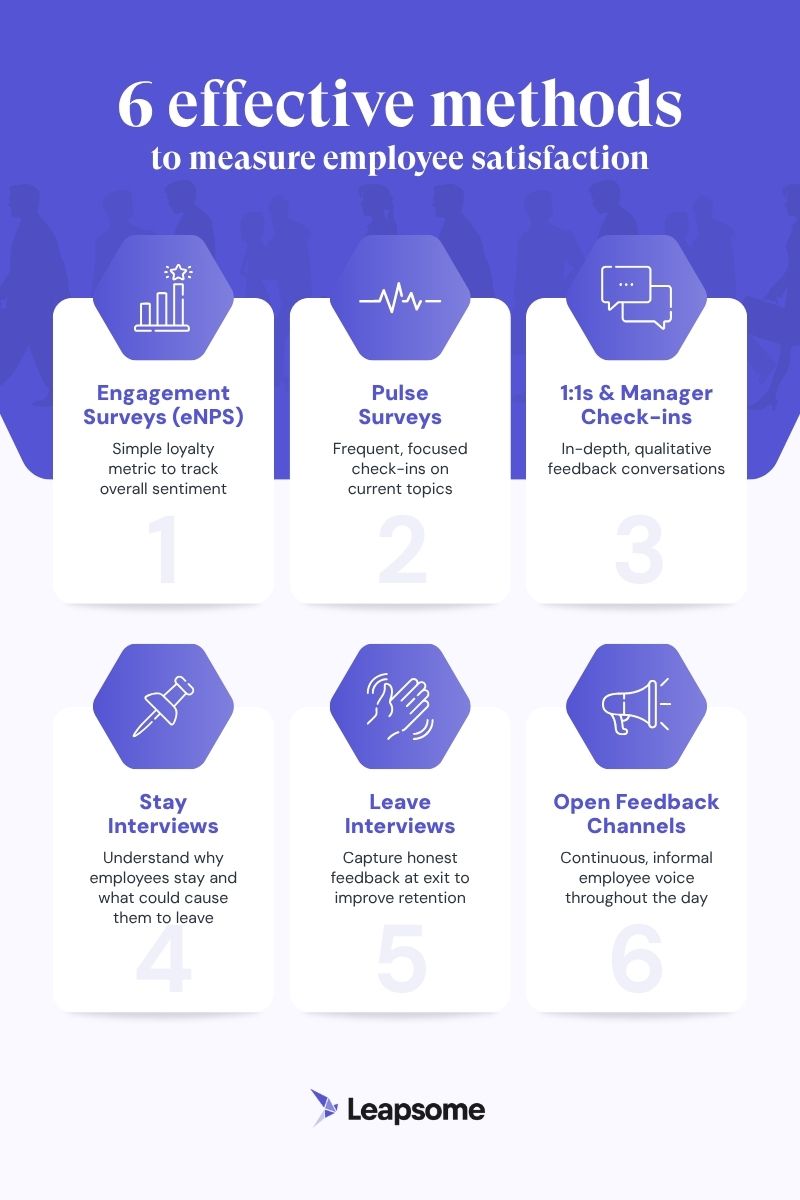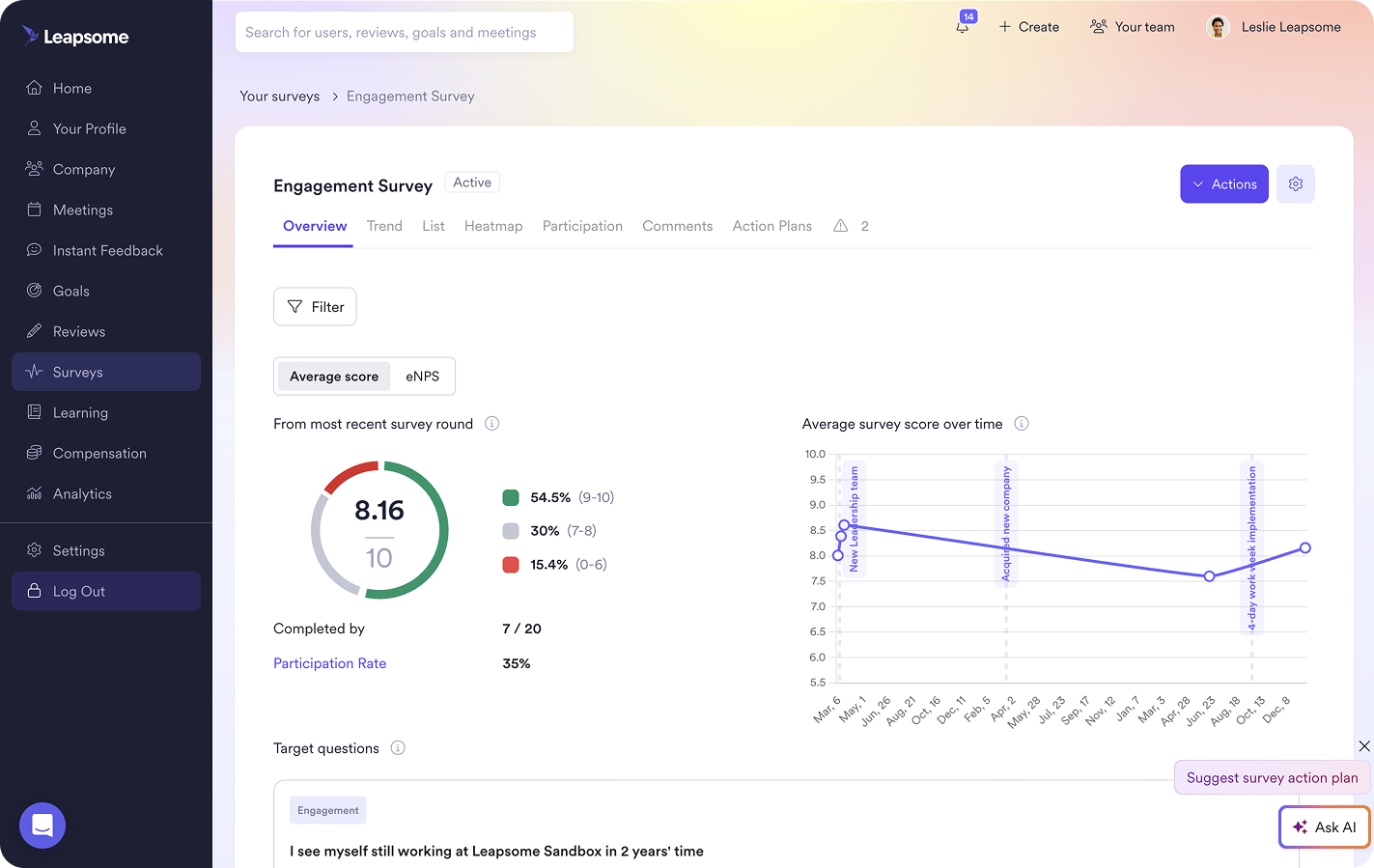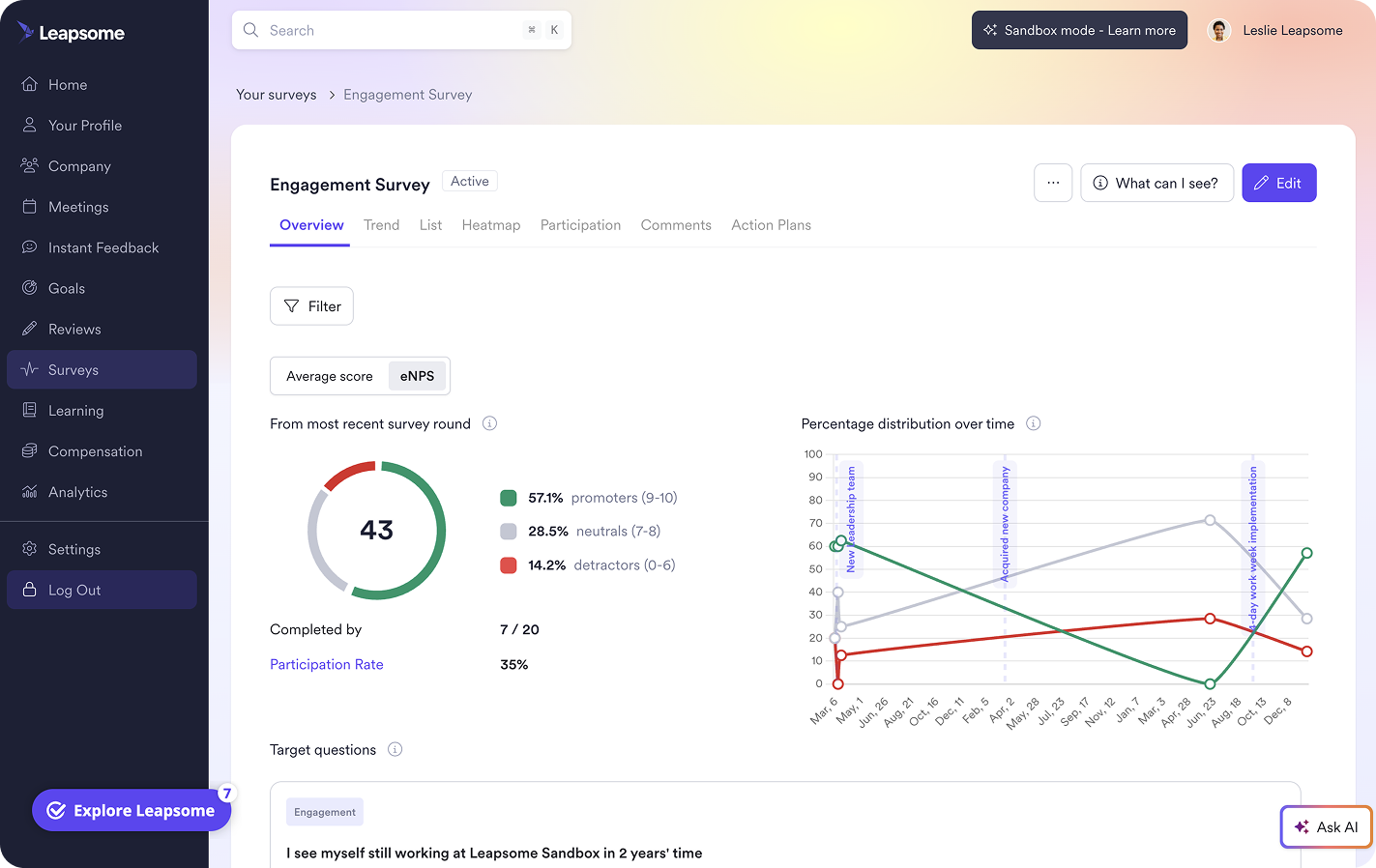How to measure employee satisfaction: 6 effective methods (with real examples + use cases)

When employees are happy, businesses thrive. Yet, knowing how happy your workforce truly is can be surprisingly tricky. You might think an annual survey or a quick pulse check is enough, but behind the scenes, issues like survey fatigue, biased answers, and unclear data often blur the real picture.
Measuring employee satisfaction isn't a checkbox exercise; it’s a strategic tool that impacts retention, productivity, and company culture. According to recent research, organizations with high employee satisfaction experience up to 21% less turnover and 14% higher productivity.* This makes understanding and acting on employee feedback crucial in today’s talent market.
This article walks you through six effective ways to measure employee satisfaction, including scalable options like eNPS and rich, qualitative insights from 1:1 check-ins. Plus, we’ll dive into 4 advanced strategies — such as combating measurement fatigue and applying psychological frameworks — that most guides miss, helping you take your employee listening to the next level.
💥 Ready to get real insights into your team’s satisfaction?
Discover how Leapsome’s all-in-one survey tools help you collect honest feedback, spot trends early, and boost retention — all without overwhelming your employees.
👉 Explore Leapsome Surveys
*Gallup, "What is Employee Engagement,” 2023

1. Engagement surveys (like eNPS)

Employee Net Promoter Score (eNPS) is one of the simplest yet most effective tools for measuring employee satisfaction at scale. It centers on a single, straightforward question: “How likely are you to recommend this company as a place to work?” Employees respond on a scale from 0 to 10, providing a clear loyalty metric that’s easy to track over time. It’s important to understand the difference between employee satisfaction vs. engagement, as these concepts influence how you interpret your survey results.
What eNPS is
eNPS is a loyalty-based employee satisfaction metric inspired by the Net Promoter Score used in customer experience. It categorizes respondents as promoters, passives, or detractors based on their rating, delivering a numeric score that reflects overall sentiment. Because it’s short and easy to answer, eNPS encourages higher response rates and enables frequent, ongoing measurement.
When to use eNPS
This method works best for mid-sized organizations aiming to monitor employee sentiment regularly without overburdening staff. eNPS surveys can be conducted quarterly or bi-monthly to spot shifts in morale early, making them ideal for companies seeking a scalable pulse on engagement. Learn more in this detailed eNPS guide to understand how to leverage this metric effectively.
Example: eNPS in action
A B2B SaaS company uses quarterly eNPS surveys to track overall team happiness. They combine the eNPS data with manager feedback scores to identify teams experiencing early signs of disengagement. This proactive approach helps HR and leadership address morale issues before they lead to increased attrition or productivity drops.
2. Pulse surveys
.jpeg)
Pulse surveys are short, frequent check-ins to capture employee sentiment on specific topics or ongoing changes. Typically consisting of 2–5 focused questions, these surveys are lightweight and easy to complete, encouraging regular participation without causing survey fatigue. To optimize your surveys, explore how to create employee pulse surveys that boost engagement without burnout.
What pulse surveys are
Pulse surveys are recurring, targeted surveys often sent weekly or monthly. They focus on timely themes like employee well-being, reaction to new policies, or feedback on leadership changes, offering a quick snapshot of current mood and issues.
When to use pulse surveys
Pulse surveys are ideal for organizations undergoing change, such as restructuring, new leadership, or policy updates. They provide rapid insights into employee reactions, helping managers and HR make real-time adjustments and communicate transparently.
Example: pulse survey in action
A fast-growing tech startup sends monthly pulse surveys after every major product launch or internal update. By analyzing the data, leadership quickly identifies stress points and areas for improvement in communication, ensuring employees feel heard and supported during rapid change.
3. 1:1s & manager check-ins
Context-rich, qualitative insights come from direct conversations between managers and employees. These one-on-one meetings allow for a deeper understanding beyond numbers, capturing emotions, concerns, and ideas in real time.
What 1:1s & manager check-ins are
1:1s are regular, scheduled meetings where managers use open-ended questions to gather honest feedback and discuss employee satisfaction, goals, and challenges. These conversations often reveal nuances that surveys miss. A proven one-on-one meeting template can help managers ask the right questions and build trust.
When to use 1:1s & manager check-ins
1:1s and manager check-ins are best suited for smaller teams or high-trust cultures, where employees feel comfortable speaking openly. 1:1s are especially valuable when teams want to build strong relationships and address individual concerns before they escalate. For managers new to this, guidance on how to conduct 1:1 meetings can be invaluable for driving meaningful conversations.
Example: 1:1s & manager check-ins in action
A boutique marketing agency schedules weekly 1:1s. Managers use these sessions to detect subtle signs of burnout or disengagement early. This proactive approach helps reduce turnover and improve team morale by addressing issues personally and promptly.
4. Stay interviews
Stay interviews are proactive, 1:1 discussions focused on understanding why employees choose to stay at a company and what might cause them to leave. Unlike exit interviews, they happen while the employee is still engaged, providing valuable insights to improve retention.
What are stay interviews?
Stay interviews are conversations between managers or HR and employees that explore job satisfaction, career aspirations, and potential challenges. The goal is to identify motivators and pain points before turnover happens. A clear set of stay interview questions ensures these discussions uncover actionable insights.
When to use stay interviews
These interviews are ideal for teams experiencing retention challenges or during times of organizational change. They help uncover issues that may not surface in surveys, especially when employees hesitate to share negative feedback openly.
Example: Stay interviews in action
A healthcare provider facing turnover issues introduces quarterly stay interviews. They discover employees value flexible scheduling and career development opportunities more than monetary incentives. Acting on these insights, they revamp their benefits, leading to a 15% decrease in voluntary departures within six months.
5. Leave interviews
Leave or exit interviews are conducted when an employee leaves the organization. They provide a final opportunity to gather honest feedback on the employee experience, uncover reasons for departure, and identify areas for improvement.
What leave interviews are
Leave interviews are structured conversations with departing employees to understand their reasons for leaving, experiences at the company, and suggestions for positive change.
When to use leave interviews
Use leave interviews consistently with every departing employee to capture valuable insights that might prevent future turnover and improve workplace culture. Analyzing exit data alongside your employee satisfaction index helps reveal broader turnover trends.
Example: Leave interviews in action
A retail chain might analyze exit interview data over a year and find a recurring theme of unclear career progression. In response, they can introduce a transparent promotion roadmap and mentorship programs, which will help reduce turnover rates in key departments by 10% the following year.
6. Open feedback channels (Slack, feedback tools)
Open feedback channels provide a continuous, informal way for employees to voice opinions, raise concerns, or share ideas throughout the workday without waiting for formal survey periods or scheduled interviews. These channels can be embedded within everyday collaboration tools like Slack and Microsoft Teams or via dedicated feedback platforms designed to capture real-time input.
What open feedback channels are
Open feedback channels function as always-on forums where employees can submit feedback spontaneously, either publicly or anonymously. This immediacy helps capture the nuances of employee sentiment as situations unfold, allowing organizations to spot trends and address issues before they escalate. Pairing these channels with people analytics tools uncovers deeper patterns and improves decision-making.
When to use open feedback channels
Open feedback channels are particularly valuable in dynamic, fast-paced environments where employee concerns may shift quickly (such as startups or companies undergoing significant change). They are also beneficial for organizations aiming to build a transparent culture by encouraging frequent dialogue and demonstrating responsiveness to employee voices.
Example: Open feedback channels in action
A fast-growing SaaS startup introduces a dedicated Slack channel for anonymous employee feedback, complemented by a simple feedback tool integrated with their HRIS. Leadership reviews summarized monthly reports and shares follow-ups in town halls. This approach identifies issues like communication gaps and workload concerns, enabling proactive interventions that increase employee trust and engagement. The continuous feedback loop also encourages employees to feel heard and valued every day, not just during survey periods.
Beyond the basics: 4 advanced practices for smarter satisfaction measurement
To truly understand and improve employee satisfaction, orgs need to move beyond standard surveys and adopt smarter, more nuanced approaches. These advanced practices help maintain engagement, ensure data quality, and align feedback with psychological insights.
How to avoid measurement fatigue
One of the biggest challenges in measuring employee satisfaction is survey fatigue, which occurs when employees feel overwhelmed or annoyed by frequent, repetitive surveys and stop engaging.
To prevent this, it’s essential to vary how you collect feedback. Rotating survey themes quarterly keeps questions fresh and relevant, covering different areas such as engagement (eNPS), diversity and inclusion, career growth, or well-being.
Combining quantitative questions (like sliders or rating scales) with qualitative options (open comments, voice notes, emoji reactions) makes surveys feel less like a chore and more interactive. Using diverse question types and a flexible employee satisfaction survey template prevents burnout and maintains engagement.
Equally important is taking visible action on survey feedback — if employees don’t see meaningful changes based on their input, they’ll quickly lose motivation to participate. Transparency about how feedback drives improvements encourages continued engagement.
✅ Use a rotating quarterly framework: one quarter for eNPS, next for DEIB, next for growth, etc., to keep feedback focused and manageable.
Legal risks & anonymization
Protecting employee privacy is crucial when collecting satisfaction data. Without careful anonymization, feedback can inadvertently reveal identities, especially in small teams or when open-text comments include personal details. This poses risks such as retaliation claims or breaches of privacy regulations.
To mitigate these risks, strip metadata from open-text responses and avoid segmenting data too granularly in small groups.
✅ Using dedicated tools designed for anonymous feedback collection (like Leapsome Surveys) helps ensure data stays confidential and compliant with privacy standards.
Prioritizing employee trust in the confidentiality of their responses leads to more honest, actionable insights.
Psychological frameworks behind satisfaction questions
Designing effective employee satisfaction surveys means going beyond simple, “Are you happy?” questions. Grounding surveys in well-established psychological theories helps uncover the deeper drivers of satisfaction and engagement.
For example, Maslow’s hierarchy of needs encourages asking about various levels — from basic safety (“I feel secure at work”) to belonging (“I feel included in my team”). Self-determination theory suggests covering autonomy, competence, and relatedness to better understand motivation. Using these frameworks helps build surveys that tap into the root causes of satisfaction, providing richer, more actionable insights.
✅ Avoid surface-level prompts; aim for questions that resonate with employees’ fundamental needs and desires.
Continuous vs. periodic measurement
Choosing the right cadence for measuring employee satisfaction depends on your organization’s culture, size, and pace of change:
- Continuous measurement uses always-on feedback tools like rolling pulse surveys or open channels (e.g., Slack feedback) to capture real-time sentiment. This approach suits fast-growing startups, dynamic teams undergoing frequent changes, or organizations that thrive on ongoing dialogue.
- Periodic measurement involves structured surveys launched quarterly or annually, providing a more stable, big-picture view. This model works well for established companies, regulated industries, or where bandwidth to process feedback is limited. Balancing or combining these approaches helps tailor feedback loops to your organization’s unique needs.
✅ Use Leapsome’s flexible survey scheduling to blend continuous pulse surveys with quarterly deep dives — so you get real-time insights without overwhelming your team. This hybrid approach keeps feedback fresh and actionable.
Empower your team with smarter satisfaction measurement

Measuring employee satisfaction is vital to retention, performance, and organizational health. Using a mix of methods, such as eNPS, pulse surveys, 1:1s, leave interviews, and open feedback channels, gives you a comprehensive view of how your people feel and what they need.
Going beyond basics by avoiding survey fatigue, respecting privacy through anonymization, applying psychological frameworks, and choosing the proper measurement cadence makes your approach smarter and more effective.
With tools like Leapsome Surveys, you can streamline these processes, making it easier to collect meaningful feedback, act on insights, and foster a culture where employees feel heard and valued.
⚡ Try Leapsome Surveys for meaningful employee feedback
Leverage advanced survey tools and insightful analytics to motivate your teams.
👉 Book a demo
Ready to transform
your People operations?
Automate, connect, and simplify all HR processes across the employee lifecycle.
.webp)
.webp)
 Request a demo today
Request a demo today







.jpeg)





















